It’s time to look back a bit and to plan for the upcoming year, but first a few congratulations are in order in recognition of some jobs well done.
The 2016 U.S. Powerboat Show in Annapolis was a great success. According to the news release just issued, space sales were up over 14 percent; attendance was up more than five percent, and exhibitors sold boats. “The mood was positive, reflective of economic indicators all trending up—especially consumer confidence and household discretionary income. There seemed to be excitement everywhere in the show,” said Paul Jacobs, president and general manager of Annapolis Boat Shows. Plans are already underway in preparation for a large and active spring powerboat show at the Bay Bridge Marina April 21 - 23, 2017 in Stevensville, MD. Last year this show featured more than 250 boats, up to 75 feet in length.
Brit Lilly of Lilly Sport Boats in Arnold, MD, recently returned from racing in Key West. Brit and his team drove his 29-foot, 650-hp
LSB Hurricane of Awesomeness to National and World 2016 High Point Champion honors in the SBI Superboat – Vee class. Congratulations to Brit and his team. Click to
proptalk.com/racer-profile-brit-lilly to read a profile on Brit Lilly.
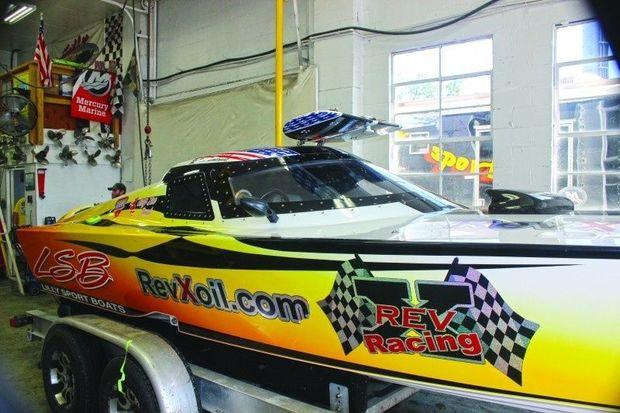 Alex Schlegel of Hartge Yacht Yard in Galesville, MD
Alex Schlegel of Hartge Yacht Yard in Galesville, MD, sends us this newsy report with a little bit of reminiscence thrown in for good measure. “Last winter was one of the best we have had since I’ve been in business in the late 70s, and this winter looks to be promising also. Spring and summer were not so good, which I attribute to the exceptionally wet, hot, and humid weather. This month we have a classic 45-foot Hatteras sportfish in the yard having the Twin Disc transmission rebuilt on one of the turbo charged Cummins. While the boat is here, we are also fixing scratches in the hull paint.
We recently rebuilt the transom on a good looking New England style 18-foot Eastern center console. The outboard mounting bolts had crushed the core. We laminated in solid fiberglass sheets in place of the core, glassed over it all, faired, and gel coated the area. Any time you are selling something, eye appeal makes a difference. To that end we are sprucing up a 1991 Grand Banks 46: prepping and painting the 25 window frames, cleaning up the engine room, and normal bottom work.”
Alex also shared some of his memories with us. “My mother, Elsie, and stepfather, Hugh Wallis, cruised the Chesapeake more extensively than anyone else I know. When it was time to give up sailing, Hugh drew plans for what he wanted in a powerboat. Sometime later I spotted an ad for exactly what he wanted: a 1988 30-foot Sundowner Sea Tug, powered by a 90-hp, four-cylinder Ford Lehman. He bought it, and they cruised some more. There were not many boats like that in those days. Now that style tug is made by Nordic, Ranger, American, and probably many more. There is a Nordic Tug 34 with a six-cylinder Yanmar 6BY3-260, a BMW diesel marinized by Yanmar, in our yard for engine work. Tugs are not what comes to mind when BMWs are mentioned, but quality and performance in an engine in any boat is a good thing.
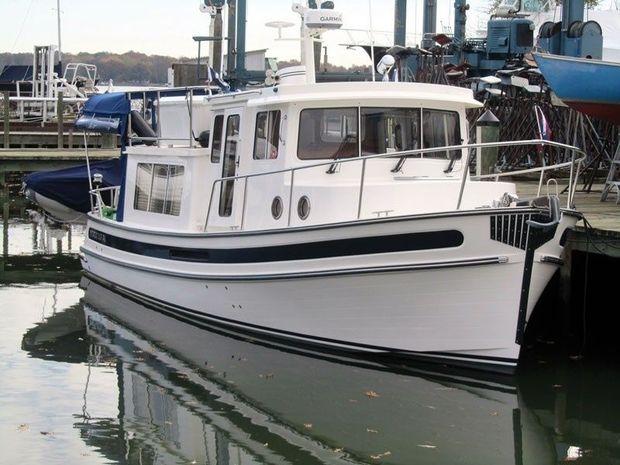
In the early 60s family friends had a 13-foot Boston Whaler with a 40-hp Johnson. We had great fun waterskiing around West River in it. A few years ago, by chance, I came into possession of two. They were of the 1961 and 1973 vintage and beat up. As you step into these older Whalers you will notice their bows have a slippery slope. Also there is no room to store lifejackets or other safety gear. To fix both of these situations we deck over about four feet of the bow using one-inch Nida-Core polypropylene honeycomb core panels. To take the hard use we give them, the gunwales are strengthened with structural putty and layers of fiberglass. After fairing and painting, they are cushioned with a large, soft-vinyl rub rail. We added them to our small fleet of runabouts that HYY technicians use as a faster way to reach boats around the river.”
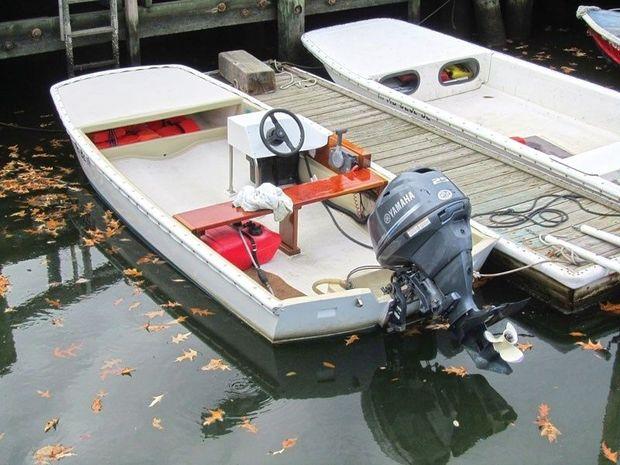 Nancy Bray Booth from Hartge Yacht Harbor in Galesville, MD
Nancy Bray Booth from Hartge Yacht Harbor in Galesville, MD, sends us this report. “At Hartge Yacht Harbor on the West River we are preparing a 1998 Sabreline 47-foot trawler for a trip around The Great Loop, which is a continuous waterway that encompasses the eastern portion of North America including the Atlantic and Gulf Intracoastal Waterways, the Great Lakes, the Canadian Canals, and the inland rivers of the United States. The trip typically is 5500 to 7000 miles, depending on the route, so careful preparation is essential.
The owner of the boat wants to be ready to depart in the spring and has already begun preparations on the boat. To avoid the spring rush, the boat was recently hauled, and the many layers of paint were peeled off the bottom. Then, after a good sanding, two fresh coats of bottom paint were applied. Washing and waxing the hull took place, and the boat has been launched where it will spend the winter in one of our covered slips. The engine will receive a tune up, all oil and filters will be changed on both the engine and generator, and all belts and hoses will be examined for wear. The customer has a new flybridge enclosure being made this winter for the trip.
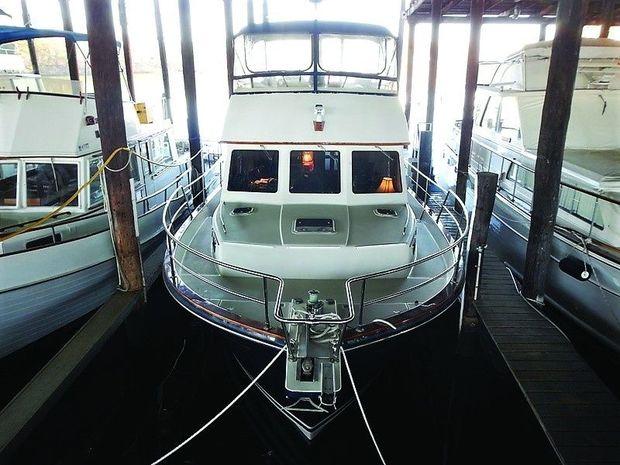
On a journey like this, stocking the boat with spare parts such as extra oil, replacement filters, spare bilge pumps, extra hoses and belts, and fuses is highly recommended. Making sure the electronics are functioning properly, obtaining current charts and guides, and having up-to-date safety equipment (flares, fire extinguishers, and first aid kits) is imperative. Hartge Yacht Harbor will be doing everything we can to insure that this customer has a safe and enjoyable experience on his well-maintained boat.”
On Tuesday, November 8, family and friends gathered at the
Calvert Marine Museum in Solomons, MD, for the dedication of the
Carol Jeanne, Southern Maryland’s one-of-a-kind, hybrid wooden boat. It began as a winter science project nine months ago for several volunteer members of the
Patuxent Small Craft Guild (PSCG), and has ended with the completion of a beautiful 20-foot open boat. Proudly owned by Bill Wright, the electric skiff follows the traditional lines of the Smith Island Crab Scrape. Wright, PSCG member, financed the project and worked in partnership with
Annapolis Hybrid Marine. The goal was to construct a lightweight vessel with a plywood hull structure equipped with an electric motor. Wright’s idea was to modify the traditional crab scrape that features a cross planked bottom and plank sided boat.
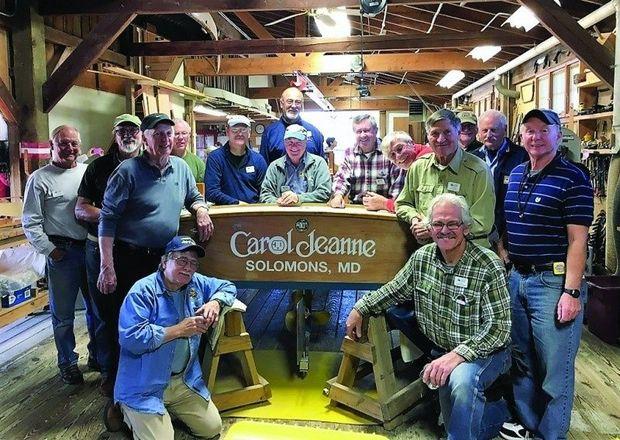
Prior to construction, volunteer Al Suydam created two scale models: a radio-controlled version to help determine seakeeping and speed, and a builder’s model to guide in the actual construction. Suydam also served as project manager. Wright’s partners, Ed Bahniuk and Ed Kobrinski, were key to the construction process. Annapolis Hybrid Marine owners, Bill DiQuinzio and Sally Reuther, served as technical advisors and assisted with the propulsion. The boat sports a Thoosa 7000-HT motor, along with a 48 Volt DC battery system.
Named after Wright’s wife, the
Carole Jeanne will be used for many fishing and crabbing trips with the grandchildren. “It was a pleasure to work with so many talented fellow Guild members who made this project a reality, and I look forward to continuing our science project once we launch,” said Wright.
John Cook of Hollywood, MD, has begun construction of a five-log, Tilghman-style sailing log canoe. John hopes to compete in the annual log canoe races on the Miles River and possibly spark new interest in this historic boat type. The process of building a log canoe is unique in that the hull is literally carved out of solid logs, as John puts it “like carving a model.”
[gallery type="square" link="file" ids="17384,17385,17386"]
John is using traditional hand tools and methods with a few modern improvements including the lofting of John’s hand-drawn hull lines on a computer by
Rick Loheed of Twisted Oyster Boatworks and advice from naval architect Paul Miller. John also credits
Kate Greenaway and the Chesapeake Bay Maritime Museum with being very helpful and supportive of his plans and efforts to recreate this unique Chesapeake watercraft.
[gallery type="square" link="file" ids="17387,17388" orderby="rand"]
by Capt. Rick Franke Alex Schlegel of Hartge Yacht Yard in Galesville, MD, sends us this newsy report with a little bit of reminiscence thrown in for good measure. “Last winter was one of the best we have had since I’ve been in business in the late 70s, and this winter looks to be promising also. Spring and summer were not so good, which I attribute to the exceptionally wet, hot, and humid weather. This month we have a classic 45-foot Hatteras sportfish in the yard having the Twin Disc transmission rebuilt on one of the turbo charged Cummins. While the boat is here, we are also fixing scratches in the hull paint.
We recently rebuilt the transom on a good looking New England style 18-foot Eastern center console. The outboard mounting bolts had crushed the core. We laminated in solid fiberglass sheets in place of the core, glassed over it all, faired, and gel coated the area. Any time you are selling something, eye appeal makes a difference. To that end we are sprucing up a 1991 Grand Banks 46: prepping and painting the 25 window frames, cleaning up the engine room, and normal bottom work.”
Alex also shared some of his memories with us. “My mother, Elsie, and stepfather, Hugh Wallis, cruised the Chesapeake more extensively than anyone else I know. When it was time to give up sailing, Hugh drew plans for what he wanted in a powerboat. Sometime later I spotted an ad for exactly what he wanted: a 1988 30-foot Sundowner Sea Tug, powered by a 90-hp, four-cylinder Ford Lehman. He bought it, and they cruised some more. There were not many boats like that in those days. Now that style tug is made by Nordic, Ranger, American, and probably many more. There is a Nordic Tug 34 with a six-cylinder Yanmar 6BY3-260, a BMW diesel marinized by Yanmar, in our yard for engine work. Tugs are not what comes to mind when BMWs are mentioned, but quality and performance in an engine in any boat is a good thing.
Alex Schlegel of Hartge Yacht Yard in Galesville, MD, sends us this newsy report with a little bit of reminiscence thrown in for good measure. “Last winter was one of the best we have had since I’ve been in business in the late 70s, and this winter looks to be promising also. Spring and summer were not so good, which I attribute to the exceptionally wet, hot, and humid weather. This month we have a classic 45-foot Hatteras sportfish in the yard having the Twin Disc transmission rebuilt on one of the turbo charged Cummins. While the boat is here, we are also fixing scratches in the hull paint.
We recently rebuilt the transom on a good looking New England style 18-foot Eastern center console. The outboard mounting bolts had crushed the core. We laminated in solid fiberglass sheets in place of the core, glassed over it all, faired, and gel coated the area. Any time you are selling something, eye appeal makes a difference. To that end we are sprucing up a 1991 Grand Banks 46: prepping and painting the 25 window frames, cleaning up the engine room, and normal bottom work.”
Alex also shared some of his memories with us. “My mother, Elsie, and stepfather, Hugh Wallis, cruised the Chesapeake more extensively than anyone else I know. When it was time to give up sailing, Hugh drew plans for what he wanted in a powerboat. Sometime later I spotted an ad for exactly what he wanted: a 1988 30-foot Sundowner Sea Tug, powered by a 90-hp, four-cylinder Ford Lehman. He bought it, and they cruised some more. There were not many boats like that in those days. Now that style tug is made by Nordic, Ranger, American, and probably many more. There is a Nordic Tug 34 with a six-cylinder Yanmar 6BY3-260, a BMW diesel marinized by Yanmar, in our yard for engine work. Tugs are not what comes to mind when BMWs are mentioned, but quality and performance in an engine in any boat is a good thing.
 In the early 60s family friends had a 13-foot Boston Whaler with a 40-hp Johnson. We had great fun waterskiing around West River in it. A few years ago, by chance, I came into possession of two. They were of the 1961 and 1973 vintage and beat up. As you step into these older Whalers you will notice their bows have a slippery slope. Also there is no room to store lifejackets or other safety gear. To fix both of these situations we deck over about four feet of the bow using one-inch Nida-Core polypropylene honeycomb core panels. To take the hard use we give them, the gunwales are strengthened with structural putty and layers of fiberglass. After fairing and painting, they are cushioned with a large, soft-vinyl rub rail. We added them to our small fleet of runabouts that HYY technicians use as a faster way to reach boats around the river.”
In the early 60s family friends had a 13-foot Boston Whaler with a 40-hp Johnson. We had great fun waterskiing around West River in it. A few years ago, by chance, I came into possession of two. They were of the 1961 and 1973 vintage and beat up. As you step into these older Whalers you will notice their bows have a slippery slope. Also there is no room to store lifejackets or other safety gear. To fix both of these situations we deck over about four feet of the bow using one-inch Nida-Core polypropylene honeycomb core panels. To take the hard use we give them, the gunwales are strengthened with structural putty and layers of fiberglass. After fairing and painting, they are cushioned with a large, soft-vinyl rub rail. We added them to our small fleet of runabouts that HYY technicians use as a faster way to reach boats around the river.”
 Nancy Bray Booth from Hartge Yacht Harbor in Galesville, MD, sends us this report. “At Hartge Yacht Harbor on the West River we are preparing a 1998 Sabreline 47-foot trawler for a trip around The Great Loop, which is a continuous waterway that encompasses the eastern portion of North America including the Atlantic and Gulf Intracoastal Waterways, the Great Lakes, the Canadian Canals, and the inland rivers of the United States. The trip typically is 5500 to 7000 miles, depending on the route, so careful preparation is essential.
The owner of the boat wants to be ready to depart in the spring and has already begun preparations on the boat. To avoid the spring rush, the boat was recently hauled, and the many layers of paint were peeled off the bottom. Then, after a good sanding, two fresh coats of bottom paint were applied. Washing and waxing the hull took place, and the boat has been launched where it will spend the winter in one of our covered slips. The engine will receive a tune up, all oil and filters will be changed on both the engine and generator, and all belts and hoses will be examined for wear. The customer has a new flybridge enclosure being made this winter for the trip.
Nancy Bray Booth from Hartge Yacht Harbor in Galesville, MD, sends us this report. “At Hartge Yacht Harbor on the West River we are preparing a 1998 Sabreline 47-foot trawler for a trip around The Great Loop, which is a continuous waterway that encompasses the eastern portion of North America including the Atlantic and Gulf Intracoastal Waterways, the Great Lakes, the Canadian Canals, and the inland rivers of the United States. The trip typically is 5500 to 7000 miles, depending on the route, so careful preparation is essential.
The owner of the boat wants to be ready to depart in the spring and has already begun preparations on the boat. To avoid the spring rush, the boat was recently hauled, and the many layers of paint were peeled off the bottom. Then, after a good sanding, two fresh coats of bottom paint were applied. Washing and waxing the hull took place, and the boat has been launched where it will spend the winter in one of our covered slips. The engine will receive a tune up, all oil and filters will be changed on both the engine and generator, and all belts and hoses will be examined for wear. The customer has a new flybridge enclosure being made this winter for the trip.
 On a journey like this, stocking the boat with spare parts such as extra oil, replacement filters, spare bilge pumps, extra hoses and belts, and fuses is highly recommended. Making sure the electronics are functioning properly, obtaining current charts and guides, and having up-to-date safety equipment (flares, fire extinguishers, and first aid kits) is imperative. Hartge Yacht Harbor will be doing everything we can to insure that this customer has a safe and enjoyable experience on his well-maintained boat.”
On Tuesday, November 8, family and friends gathered at the Calvert Marine Museum in Solomons, MD, for the dedication of the Carol Jeanne, Southern Maryland’s one-of-a-kind, hybrid wooden boat. It began as a winter science project nine months ago for several volunteer members of the Patuxent Small Craft Guild (PSCG), and has ended with the completion of a beautiful 20-foot open boat. Proudly owned by Bill Wright, the electric skiff follows the traditional lines of the Smith Island Crab Scrape. Wright, PSCG member, financed the project and worked in partnership with Annapolis Hybrid Marine. The goal was to construct a lightweight vessel with a plywood hull structure equipped with an electric motor. Wright’s idea was to modify the traditional crab scrape that features a cross planked bottom and plank sided boat.
On a journey like this, stocking the boat with spare parts such as extra oil, replacement filters, spare bilge pumps, extra hoses and belts, and fuses is highly recommended. Making sure the electronics are functioning properly, obtaining current charts and guides, and having up-to-date safety equipment (flares, fire extinguishers, and first aid kits) is imperative. Hartge Yacht Harbor will be doing everything we can to insure that this customer has a safe and enjoyable experience on his well-maintained boat.”
On Tuesday, November 8, family and friends gathered at the Calvert Marine Museum in Solomons, MD, for the dedication of the Carol Jeanne, Southern Maryland’s one-of-a-kind, hybrid wooden boat. It began as a winter science project nine months ago for several volunteer members of the Patuxent Small Craft Guild (PSCG), and has ended with the completion of a beautiful 20-foot open boat. Proudly owned by Bill Wright, the electric skiff follows the traditional lines of the Smith Island Crab Scrape. Wright, PSCG member, financed the project and worked in partnership with Annapolis Hybrid Marine. The goal was to construct a lightweight vessel with a plywood hull structure equipped with an electric motor. Wright’s idea was to modify the traditional crab scrape that features a cross planked bottom and plank sided boat.
 Prior to construction, volunteer Al Suydam created two scale models: a radio-controlled version to help determine seakeeping and speed, and a builder’s model to guide in the actual construction. Suydam also served as project manager. Wright’s partners, Ed Bahniuk and Ed Kobrinski, were key to the construction process. Annapolis Hybrid Marine owners, Bill DiQuinzio and Sally Reuther, served as technical advisors and assisted with the propulsion. The boat sports a Thoosa 7000-HT motor, along with a 48 Volt DC battery system.
Named after Wright’s wife, the Carole Jeanne will be used for many fishing and crabbing trips with the grandchildren. “It was a pleasure to work with so many talented fellow Guild members who made this project a reality, and I look forward to continuing our science project once we launch,” said Wright.
John Cook of Hollywood, MD, has begun construction of a five-log, Tilghman-style sailing log canoe. John hopes to compete in the annual log canoe races on the Miles River and possibly spark new interest in this historic boat type. The process of building a log canoe is unique in that the hull is literally carved out of solid logs, as John puts it “like carving a model.”
[gallery type="square" link="file" ids="17384,17385,17386"]
John is using traditional hand tools and methods with a few modern improvements including the lofting of John’s hand-drawn hull lines on a computer by Rick Loheed of Twisted Oyster Boatworks and advice from naval architect Paul Miller. John also credits Kate Greenaway and the Chesapeake Bay Maritime Museum with being very helpful and supportive of his plans and efforts to recreate this unique Chesapeake watercraft.
[gallery type="square" link="file" ids="17387,17388" orderby="rand"]
by Capt. Rick Franke
Prior to construction, volunteer Al Suydam created two scale models: a radio-controlled version to help determine seakeeping and speed, and a builder’s model to guide in the actual construction. Suydam also served as project manager. Wright’s partners, Ed Bahniuk and Ed Kobrinski, were key to the construction process. Annapolis Hybrid Marine owners, Bill DiQuinzio and Sally Reuther, served as technical advisors and assisted with the propulsion. The boat sports a Thoosa 7000-HT motor, along with a 48 Volt DC battery system.
Named after Wright’s wife, the Carole Jeanne will be used for many fishing and crabbing trips with the grandchildren. “It was a pleasure to work with so many talented fellow Guild members who made this project a reality, and I look forward to continuing our science project once we launch,” said Wright.
John Cook of Hollywood, MD, has begun construction of a five-log, Tilghman-style sailing log canoe. John hopes to compete in the annual log canoe races on the Miles River and possibly spark new interest in this historic boat type. The process of building a log canoe is unique in that the hull is literally carved out of solid logs, as John puts it “like carving a model.”
[gallery type="square" link="file" ids="17384,17385,17386"]
John is using traditional hand tools and methods with a few modern improvements including the lofting of John’s hand-drawn hull lines on a computer by Rick Loheed of Twisted Oyster Boatworks and advice from naval architect Paul Miller. John also credits Kate Greenaway and the Chesapeake Bay Maritime Museum with being very helpful and supportive of his plans and efforts to recreate this unique Chesapeake watercraft.
[gallery type="square" link="file" ids="17387,17388" orderby="rand"]
by Capt. Rick Franke